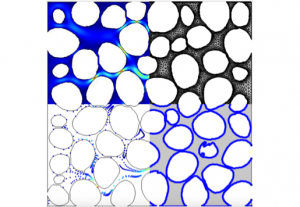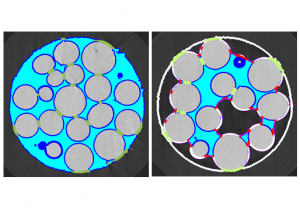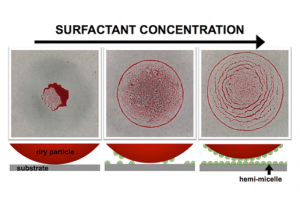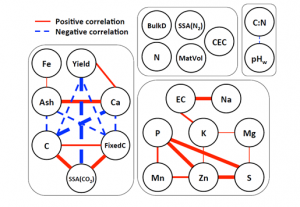 Anomalous transport in porous media
Anomalous transport in porous media
Early/delayed arrival of solutes leads to poor mixing and long residence times, and is a phenomenon known as ”anomalous transport”. Typical upscaling transport models attribute anomalous transport behavior to structures like fractures. Nevertheless, anomalous transport has been observed even in highly homogeneous porous media. This work aims to establish formal relationships between structural features of the pore-space and the observed intensity of anomalous transport.
Publications: Carrel et al., (Under review); Carrel et al., 2017; Morales et al., (2017); Holzner et al., 2015
 Soil architecture effects on colloid filtration
Soil architecture effects on colloid filtration
Landfill and agricultural soils are expected to receive large loads of nano-silver (nAg) through land application of wastewater sludge. This puts beneficial soil-microbes at risk because nAg is an indiscriminate antimicrobial agent. The aim of this study is to assess the efficiency of interfaces within pores in immobilizing nAg and other emerging environmental nano-contaminants for various typical moisture contents and chemistry conditions to establish the best land management conditions to contain contaminant dispersion.
Publications: Morales et al. (In preparation); Morales et al., 2011; Morales et al., 2009
Enhanced transport of colloids
Transport of colloid contaminants is enhanced in soils ammended with manure, but the mechanisms are not well understood. Results of this work indicate that organic matter from manure creates a hairy structure on the colloid surface called the “corona”. The hair length, density and electrostatic charge of this structure greatly alters the short-range forces that provide particles with stability. When the hairy layer is dense and uniform, the colloids are typically highly mobile. When the hairy layer is sparse the colloids become entangled and deposited.
Publications: Sang et al., 2014; Wang et al., 2012; Morales et al., 2011a; Morales et al.,2011b
 Drying drop dynamics
Drying drop dynamics
Evaporation deposition is a common process observed daily in coffee-stains, yet it is central to the microfabrication industry. This work provides a framework for controlling the shape and attachment strength of deposition stains with solutes. Specifically, we show that the addition of nonionic surfactant can be tuned to control (i) the surface tension of the drop, (ii) dynamics of the contact line during evaporation, (iii) colloid-substrate friction, (iv) morphology of deposited stains, and (v) attachment strength of stains.
Publications: Zhao et al., (In preparation); Morales et al., 2013
Reverse engineering of Biochar
Biochar is a growingly popular biomass carbonization tool with wide-ranging agronomic and environmental gains. However, the benefits of adding biochar to a soil greatly depend on how it is produced. In an effort to formulate “production recipies”, this study built a meta-data library from which links between biochar physico-chemical properties and production parameters were statistically ascertained. Based on these relationships, the Biochar Engineering web-tool was constructed to help producers determine the optimal parameters needed to generate biochar that is tailored to mitigate specific soil deficiencies.
Publications: Morales et al., 2015; Zhang et al., 2010







